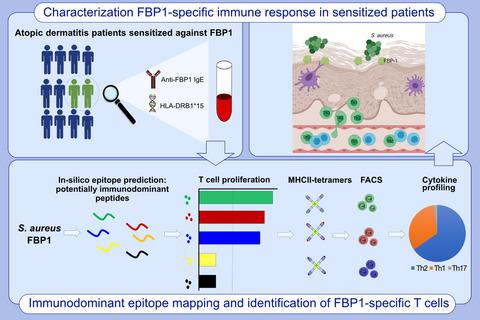Our official English website, www.x-mol.net, welcomes your feedback! (Note: you will need to create a separate account there.)
Specific T cells targeting Staphylococcus aureus fibronectin-binding protein 1 induce a type 2/type 1 inflammatory response in sensitized atopic dermatitis patients
Allergy ( IF 12.4 ) Pub Date : 2021-10-03 , DOI: 10.1111/all.15120 Ahmed K Farag 1 , Lennart M Roesner 1, 2 , Susanne Wieschowski 1 , Annice Heratizadeh 1 , Britta Eiz-Vesper 3 , William W Kwok 4, 5 , Rudolf Valenta 6, 7, 8, 9 , Thomas Werfel 1, 2
Allergy ( IF 12.4 ) Pub Date : 2021-10-03 , DOI: 10.1111/all.15120 Ahmed K Farag 1 , Lennart M Roesner 1, 2 , Susanne Wieschowski 1 , Annice Heratizadeh 1 , Britta Eiz-Vesper 3 , William W Kwok 4, 5 , Rudolf Valenta 6, 7, 8, 9 , Thomas Werfel 1, 2
Affiliation

|
Atopic dermatitis (AD) is one of the most common inflammatory skin diseases worldwide and Staphylococcus aureus colonization and secondary infections occur in the majority of AD patients. Allergic sensitizations against microbial antigens have been discussed as possible trigger factors of AD. Recently, we reported IgE sensitization against fibronectin-binding protein 1 (FBP1), an essential virulence component in S. aureus, in a subgroup of patients suffering from AD. To expand these findings by investigating delayed-type immune reactions, the objective of this study was to detect and phenotypically characterize FBP1-specific T cells as possible trigger factors in AD.
中文翻译:

靶向金黄色葡萄球菌纤连蛋白结合蛋白 1 的特异性 T 细胞在致敏性特应性皮炎患者中诱导 2 型/1 型炎症反应
特应性皮炎 (AD) 是世界范围内最常见的炎症性皮肤病之一,大多数 AD 患者都会发生金黄色葡萄球菌定植和继发感染。对微生物抗原的过敏致敏已被讨论为 AD 的可能触发因素。最近,我们报道了 IgE 对纤连蛋白结合蛋白 1 (FBP1) 的敏化作用,FBP1 是S中的重要毒力成分。 金黄色葡萄球菌,在患有 AD 的患者亚组中。为了通过研究延迟型免疫反应来扩展这些发现,本研究的目的是检测和表型表征 FBP1 特异性 T 细胞作为 AD 中可能的触发因素。
更新日期:2021-10-03
中文翻译:

靶向金黄色葡萄球菌纤连蛋白结合蛋白 1 的特异性 T 细胞在致敏性特应性皮炎患者中诱导 2 型/1 型炎症反应
特应性皮炎 (AD) 是世界范围内最常见的炎症性皮肤病之一,大多数 AD 患者都会发生金黄色葡萄球菌定植和继发感染。对微生物抗原的过敏致敏已被讨论为 AD 的可能触发因素。最近,我们报道了 IgE 对纤连蛋白结合蛋白 1 (FBP1) 的敏化作用,FBP1 是S中的重要毒力成分。 金黄色葡萄球菌,在患有 AD 的患者亚组中。为了通过研究延迟型免疫反应来扩展这些发现,本研究的目的是检测和表型表征 FBP1 特异性 T 细胞作为 AD 中可能的触发因素。


























 京公网安备 11010802027423号
京公网安备 11010802027423号